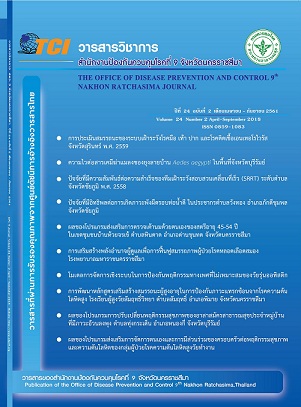Susceptibility to Temephos, Alphacypermethrin, Deltamethrin, Lamda-cyhalothrin and Cypermethrin to Aedes aegypti in Buriram Province
Keywords:
Susceptibility, Aedes aegypti, InsecticidesAbstract
The objective of study to investigate the susceptibility to Temephos, Alphacypermethr
in Deltamethrin, Lambda-cyhalothrin and Cypermethrin of Aedesa egypti from Buriram Province,
Collected from four sub-districts including NaiMueang, SawaiChik, LahanSai and KokWan.
The F1 progenies of Ae.aegypti colony, were used in the susceptibility test apply procedures of
World Health Organization. For larval bioassay, the late third or early four instar were test to
0.012 mg/L of Temephos solution as recommended by the World Health Organization as a standard
method. For adult bioassay, the female were exposed to Alphacypermethrin 0.08%, Deltamethrin
0.05%, Lambda-cyhalothrin 0.03%, and Cypermethrin 0.22% standard insecticide papers.
The percent mortality rate count was made 24 hrs after exposed and data interpretation of result
determined susceptibility or resistance, World Health Organization. The result indicated mortality
rate of Temephosfor the larvae from NaiMueang, SawaiChik, KokWan and LahanSai sub-districts
was 98%, 95%, 76% and69%, respectively. For adult bioassay, The mortality rate of Alphacy
permethrin 0.08%, Deltamethrin 0.05%, Lambda-cyhalothrin 0.03%, and Cypermethrin 0.22%
ranging from 19% to 77%. Conclusion, The data indicated Ae. Aegypti all incipient of resistance
to temephos. However, the susceptibility were found in NaiMueang sub-districts. All adult
population of Ae. aegypti were found resistance to Alphacypermethrin, Deltamethrin, Lambda-cyhalothrin
and Cypermethrin. These results suggest that routine and comprehensive susceptibility monitoring
of dengue mosquito vectors to insecticide and should be a required component of resistance management
policies and disease control activities.
References
Available from: http://www.who.int/mediacentre/factsheets/fs117/en/.
2. Gubler DJ. Dengue and dengue haemorrhagicfever.Journal of Clinical Microbiology 1998; 11:
480-496.
3. Guzman GM, Halstead SB, Artsob H, Buchy P, Farrar J, Gubler DJ, et al. Dengue: a continuing
global threat. Nature Reviews Microbiology 2010; 328: 745-748.
4. Prasittisuk C, AndjaparidzeAG, Vijay Kumar.Current Status of Dengue/Dengue Haemorrhagic
Fever in WHO South-East Asia Region.Dengue Bulletin 1998; 22: 1-15.
5. Komalamisra N, Srisawat R, Phanbhuwong T, Oatwaree S. Insecticide Susceptibility of The
Dengue Vector, Aedesaegypti (L.) in Metropolitan Bankok. Southeast Asian J Trop Med
Public Health.2011; 42(4): 814-823.
6. สีวิกา แสงธาราทิพย์. ยุงลายพาหะนำ�โรคไข้เลือดออก. ใน: สีวิกา แสงธาราทิพย์, บรรณาธิการ.
โรคไข้เลือดออก ฉบับประเกียรณก. พิมพ์ครั้งที่ 2. นนทบุรี: โรงพิมพ์ชุมนุมสหกรณ์การเกษตร
แห่งประเทศไทย. 2545.
7. World Health Organization. Vector control operations framework for Zika virus. 2016; WHO/
ZIKV/VC/16.4: 1-10.
8. Thongwat D, Bunchu N. Susceptibility to Temephos, Permethrin and Deltamethrin of Aedesaegypti
(Diptera: Culicidae) from Muang district, Phitsanulok Province, Thailand. Asian Pacific Journal
of Tropical Medicine.2015; 14-18.
9. Rattanarithikul R, Harbach RE, Harrison BA, Panthusiri P, Coleman RE, Richardson JH. Illustrated
Keys to the Mosquitoes of Thailand VI. Tribe Aedini.The Southeast Asian Journal of Tropical
Medicine and Public Health. 2010; 41(1): 1-225.
10. World Health Organization. Instructions for determining the susceptibility of resistance of mosquito
larvae to insecticides. WHO/VBC/81.807. 1981.
11. World Health Organization. Instruction for determining the susceptibility or resistance of adult
mosquitoes to oganochlorine, organophosphate and carbamate insecticides – diagnostic dose.
WHO/VBC/81.806 Corr.1. 1981.
12. World Health Organization. Test procedures for insecticideresistance monitoring in malaria
vector, bio-efficacy andpersistence of insecticides on treated surfaces. 1998.
13. Sornpeng W, Pimsamarn S, Akksilp S. Resistance to Temephos of Aedesaegypti Linnaeus Larvae
(Diptera: Culicidae). Journal of Health Science. 2009; 18(5): 650-654.
14. Jirakanjanakit N, Saengtharatip S, Ongoparat P, Duchon S, Bellec C, Yoksan S. Trend of
Temephos Resistance in Aedes (Stegomyia) Mosquitoes in Thailand During 2003–2005.
Environmental Entomology 2007; 36(3): 506-511.
15. Ponlawat A, Scott JG, Harrington LC. Insecticide Susceptibility of Aedesaegypti and Aedesalbopictus
across Thailand.Journal of Medical Entomology2005. 42(5): 821-825.
16. Paeporn P, Supaphathom K, Sathantriphop S, Mukkhun S, Sangkitporn S. Insecticide Susceptibility
of Aedesaegypti in Tsunami-affected Areas in Thailand. Dengue Bulletin.2005; 29: 210-213.
17. Paeporn P, Supaphathom K, Wattanachai P, Sathantriphop S, Ya-umphan P, Deesin V. Insecticide
Susceptibility of Aedesaegypti in Different Parts of Thailand. Journal of Tropical Medicine
and Parasitology 2006. 29(1): 1-5.
18. Thanispong K, Pankaew K, Sukchote P. Insecticide susceptibility/resistance status in Aedesaegypti L.
to insecticides used in Public Health. Journal of the Vector-borne Diseases. 2011. 8(2): 28-43.
19. Chuaycharoensuk T, Juntarajumnong W, Boonyuan W, Bangs MJ, Akratanakul P, Thammapalo S,
Jirakanjanakit N, et al. Frequency of pyrethroid resistance in Aedesaegypti and Aedesalbopictus
(Diptera: Culicidae) in Thailand. Journal of Vector Ecology. 2011. 36(1): 204-212.
20. Chareonviriyahpap T, Aum-aung B, Ratanatham S. Current Insecticide Resistance Patterns
in Mosquito Vectors in Thailand. Southeast Asian J Trop Med Public Health.1999; 3:
184-194.
21. Brogdon WG, McAllister JC. Synopses: insecticide and vector control. Emerging Infectious
Diseases journal 1998; 4: 605-613.

Downloads
Published
How to Cite
Issue
Section
License
บทความที่ลงพิมพ์ในวารสารวิชาการสำนักงานป้องกันควบคุมโรคที่ 9 จังหวัดนครราชสีมา ถือว่าเป็น
ลิขสิทธิ์ สำนักงานป้องกันควบคุมโรคที่ 9 จังหวัดนครราชสีมา



